Xingliang Yuan
MulVuln: Enhancing Pre-trained LMs with Shared and Language-Specific Knowledge for Multilingual Vulnerability Detection
Oct 05, 2025Abstract:Software vulnerabilities (SVs) pose a critical threat to safety-critical systems, driving the adoption of AI-based approaches such as machine learning and deep learning for software vulnerability detection. Despite promising results, most existing methods are limited to a single programming language. This is problematic given the multilingual nature of modern software, which is often complex and written in multiple languages. Current approaches often face challenges in capturing both shared and language-specific knowledge of source code, which can limit their performance on diverse programming languages and real-world codebases. To address this gap, we propose MULVULN, a novel multilingual vulnerability detection approach that learns from source code across multiple languages. MULVULN captures both the shared knowledge that generalizes across languages and the language-specific knowledge that reflects unique coding conventions. By integrating these aspects, it achieves more robust and effective detection of vulnerabilities in real-world multilingual software systems. The rigorous and extensive experiments on the real-world and diverse REEF dataset, consisting of 4,466 CVEs with 30,987 patches across seven programming languages, demonstrate the superiority of MULVULN over thirteen effective and state-of-the-art baselines. Notably, MULVULN achieves substantially higher F1-score, with improvements ranging from 1.45% to 23.59% compared to the baseline methods.
Robust Anomaly Detection in O-RAN: Leveraging LLMs against Data Manipulation Attacks
Aug 11, 2025Abstract:The introduction of 5G and the Open Radio Access Network (O-RAN) architecture has enabled more flexible and intelligent network deployments. However, the increased complexity and openness of these architectures also introduce novel security challenges, such as data manipulation attacks on the semi-standardised Shared Data Layer (SDL) within the O-RAN platform through malicious xApps. In particular, malicious xApps can exploit this vulnerability by introducing subtle Unicode-wise alterations (hypoglyphs) into the data that are being used by traditional machine learning (ML)-based anomaly detection methods. These Unicode-wise manipulations can potentially bypass detection and cause failures in anomaly detection systems based on traditional ML, such as AutoEncoders, which are unable to process hypoglyphed data without crashing. We investigate the use of Large Language Models (LLMs) for anomaly detection within the O-RAN architecture to address this challenge. We demonstrate that LLM-based xApps maintain robust operational performance and are capable of processing manipulated messages without crashing. While initial detection accuracy requires further improvements, our results highlight the robustness of LLMs to adversarial attacks such as hypoglyphs in input data. There is potential to use their adaptability through prompt engineering to further improve the accuracy, although this requires further research. Additionally, we show that LLMs achieve low detection latency (under 0.07 seconds), making them suitable for Near-Real-Time (Near-RT) RIC deployments.
Self-Adaptive and Robust Federated Spectrum Sensing without Benign Majority for Cellular Networks
Jul 16, 2025Abstract:Advancements in wireless and mobile technologies, including 5G advanced and the envisioned 6G, are driving exponential growth in wireless devices. However, this rapid expansion exacerbates spectrum scarcity, posing a critical challenge. Dynamic spectrum allocation (DSA)--which relies on sensing and dynamically sharing spectrum--has emerged as an essential solution to address this issue. While machine learning (ML) models hold significant potential for improving spectrum sensing, their adoption in centralized ML-based DSA systems is limited by privacy concerns, bandwidth constraints, and regulatory challenges. To overcome these limitations, distributed ML-based approaches such as Federated Learning (FL) offer promising alternatives. This work addresses two key challenges in FL-based spectrum sensing (FLSS). First, the scarcity of labeled data for training FL models in practical spectrum sensing scenarios is tackled with a semi-supervised FL approach, combined with energy detection, enabling model training on unlabeled datasets. Second, we examine the security vulnerabilities of FLSS, focusing on the impact of data poisoning attacks. Our analysis highlights the shortcomings of existing majority-based defenses in countering such attacks. To address these vulnerabilities, we propose a novel defense mechanism inspired by vaccination, which effectively mitigates data poisoning attacks without relying on majority-based assumptions. Extensive experiments on both synthetic and real-world datasets validate our solutions, demonstrating that FLSS can achieve near-perfect accuracy on unlabeled datasets and maintain Byzantine robustness against both targeted and untargeted data poisoning attacks, even when a significant proportion of participants are malicious.
THEMIS: Towards Practical Intellectual Property Protection for Post-Deployment On-Device Deep Learning Models
Mar 31, 2025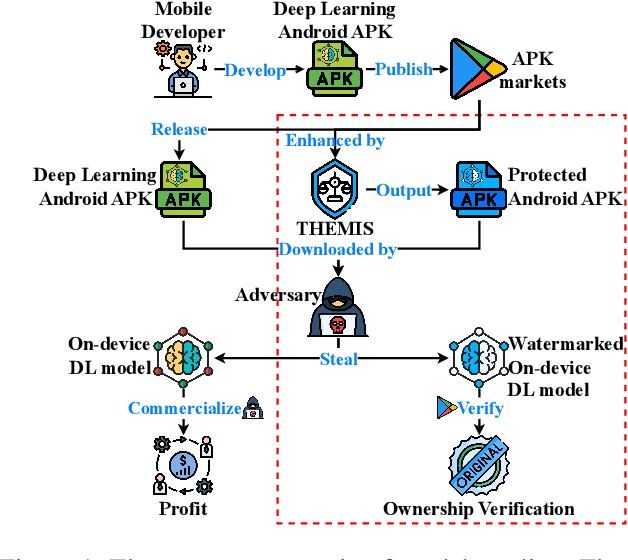

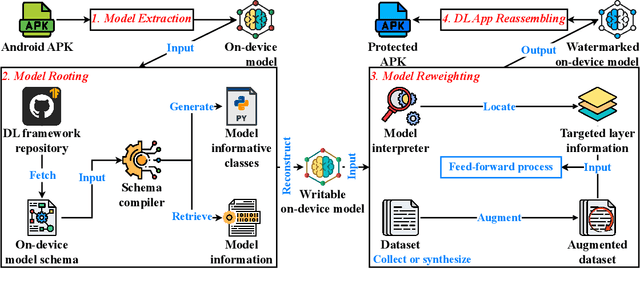

Abstract:On-device deep learning (DL) has rapidly gained adoption in mobile apps, offering the benefits of offline model inference and user privacy preservation over cloud-based approaches. However, it inevitably stores models on user devices, introducing new vulnerabilities, particularly model-stealing attacks and intellectual property infringement. While system-level protections like Trusted Execution Environments (TEEs) provide a robust solution, practical challenges remain in achieving scalable on-device DL model protection, including complexities in supporting third-party models and limited adoption in current mobile solutions. Advancements in TEE-enabled hardware, such as NVIDIA's GPU-based TEEs, may address these obstacles in the future. Currently, watermarking serves as a common defense against model theft but also faces challenges here as many mobile app developers lack corresponding machine learning expertise and the inherent read-only and inference-only nature of on-device DL models prevents third parties like app stores from implementing existing watermarking techniques in post-deployment models. To protect the intellectual property of on-device DL models, in this paper, we propose THEMIS, an automatic tool that lifts the read-only restriction of on-device DL models by reconstructing their writable counterparts and leverages the untrainable nature of on-device DL models to solve watermark parameters and protect the model owner's intellectual property. Extensive experimental results across various datasets and model structures show the superiority of THEMIS in terms of different metrics. Further, an empirical investigation of 403 real-world DL mobile apps from Google Play is performed with a success rate of 81.14%, showing the practicality of THEMIS.
FedMobile: Enabling Knowledge Contribution-aware Multi-modal Federated Learning with Incomplete Modalities
Feb 20, 2025Abstract:The Web of Things (WoT) enhances interoperability across web-based and ubiquitous computing platforms while complementing existing IoT standards. The multimodal Federated Learning (FL) paradigm has been introduced to enhance WoT by enabling the fusion of multi-source mobile sensing data while preserving privacy. However, a key challenge in mobile sensing systems using multimodal FL is modality incompleteness, where some modalities may be unavailable or only partially captured, potentially degrading the system's performance and reliability. Current multimodal FL frameworks typically train multiple unimodal FL subsystems or apply interpolation techniques on the node side to approximate missing modalities. However, these approaches overlook the shared latent feature space among incomplete modalities across different nodes and fail to discriminate against low-quality nodes. To address this gap, we present FedMobile, a new knowledge contribution-aware multimodal FL framework designed for robust learning despite missing modalities. FedMobile prioritizes local-to-global knowledge transfer, leveraging cross-node multimodal feature information to reconstruct missing features. It also enhances system performance and resilience to modality heterogeneity through rigorous node contribution assessments and knowledge contribution-aware aggregation rules. Empirical evaluations on five widely recognized multimodal benchmark datasets demonstrate that FedMobile maintains robust learning even when up to 90% of modality information is missing or when data from two modalities are randomly missing, outperforming state-of-the-art baselines.
GRID: Protecting Training Graph from Link Stealing Attacks on GNN Models
Jan 19, 2025



Abstract:Graph neural networks (GNNs) have exhibited superior performance in various classification tasks on graph-structured data. However, they encounter the potential vulnerability from the link stealing attacks, which can infer the presence of a link between two nodes via measuring the similarity of its incident nodes' prediction vectors produced by a GNN model. Such attacks pose severe security and privacy threats to the training graph used in GNN models. In this work, we propose a novel solution, called Graph Link Disguise (GRID), to defend against link stealing attacks with the formal guarantee of GNN model utility for retaining prediction accuracy. The key idea of GRID is to add carefully crafted noises to the nodes' prediction vectors for disguising adjacent nodes as n-hop indirect neighboring nodes. We take into account the graph topology and select only a subset of nodes (called core nodes) covering all links for adding noises, which can avert the noises offset and have the further advantages of reducing both the distortion loss and the computation cost. Our crafted noises can ensure 1) the noisy prediction vectors of any two adjacent nodes have their similarity level like that of two non-adjacent nodes and 2) the model prediction is unchanged to ensure zero utility loss. Extensive experiments on five datasets are conducted to show the effectiveness of our proposed GRID solution against different representative link-stealing attacks under transductive settings and inductive settings respectively, as well as two influence-based attacks. Meanwhile, it achieves a much better privacy-utility trade-off than existing methods when extended to GNNs.
Arondight: Red Teaming Large Vision Language Models with Auto-generated Multi-modal Jailbreak Prompts
Jul 21, 2024



Abstract:Large Vision Language Models (VLMs) extend and enhance the perceptual abilities of Large Language Models (LLMs). Despite offering new possibilities for LLM applications, these advancements raise significant security and ethical concerns, particularly regarding the generation of harmful content. While LLMs have undergone extensive security evaluations with the aid of red teaming frameworks, VLMs currently lack a well-developed one. To fill this gap, we introduce Arondight, a standardized red team framework tailored specifically for VLMs. Arondight is dedicated to resolving issues related to the absence of visual modality and inadequate diversity encountered when transitioning existing red teaming methodologies from LLMs to VLMs. Our framework features an automated multi-modal jailbreak attack, wherein visual jailbreak prompts are produced by a red team VLM, and textual prompts are generated by a red team LLM guided by a reinforcement learning agent. To enhance the comprehensiveness of VLM security evaluation, we integrate entropy bonuses and novelty reward metrics. These elements incentivize the RL agent to guide the red team LLM in creating a wider array of diverse and previously unseen test cases. Our evaluation of ten cutting-edge VLMs exposes significant security vulnerabilities, particularly in generating toxic images and aligning multi-modal prompts. In particular, our Arondight achieves an average attack success rate of 84.5\% on GPT-4 in all fourteen prohibited scenarios defined by OpenAI in terms of generating toxic text. For a clearer comparison, we also categorize existing VLMs based on their safety levels and provide corresponding reinforcement recommendations. Our multimodal prompt dataset and red team code will be released after ethics committee approval. CONTENT WARNING: THIS PAPER CONTAINS HARMFUL MODEL RESPONSES.
Security and Privacy of 6G Federated Learning-enabled Dynamic Spectrum Sharing
Jun 18, 2024



Abstract:Spectrum sharing is increasingly vital in 6G wireless communication, facilitating dynamic access to unused spectrum holes. Recently, there has been a significant shift towards employing machine learning (ML) techniques for sensing spectrum holes. In this context, federated learning (FL)-enabled spectrum sensing technology has garnered wide attention, allowing for the construction of an aggregated ML model without disclosing the private spectrum sensing information of wireless user devices. However, the integrity of collaborative training and the privacy of spectrum information from local users have remained largely unexplored. This article first examines the latest developments in FL-enabled spectrum sharing for prospective 6G scenarios. It then identifies practical attack vectors in 6G to illustrate potential AI-powered security and privacy threats in these contexts. Finally, the study outlines future directions, including practical defense challenges and guidelines.
BadSampler: Harnessing the Power of Catastrophic Forgetting to Poison Byzantine-robust Federated Learning
Jun 18, 2024
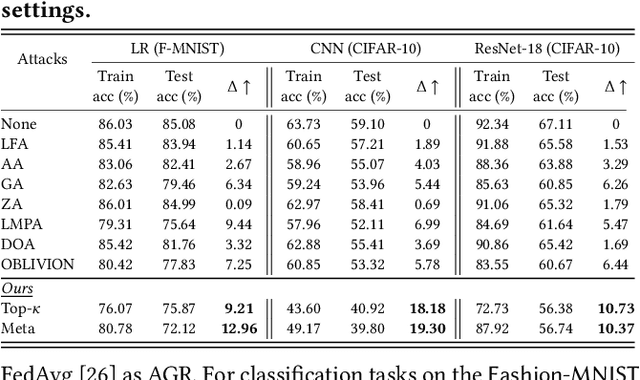
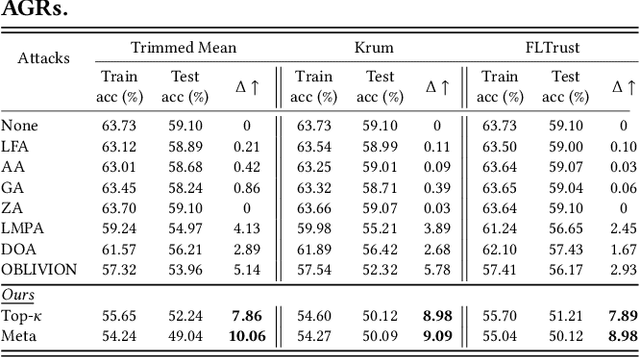

Abstract:Federated Learning (FL) is susceptible to poisoning attacks, wherein compromised clients manipulate the global model by modifying local datasets or sending manipulated model updates. Experienced defenders can readily detect and mitigate the poisoning effects of malicious behaviors using Byzantine-robust aggregation rules. However, the exploration of poisoning attacks in scenarios where such behaviors are absent remains largely unexplored for Byzantine-robust FL. This paper addresses the challenging problem of poisoning Byzantine-robust FL by introducing catastrophic forgetting. To fill this gap, we first formally define generalization error and establish its connection to catastrophic forgetting, paving the way for the development of a clean-label data poisoning attack named BadSampler. This attack leverages only clean-label data (i.e., without poisoned data) to poison Byzantine-robust FL and requires the adversary to selectively sample training data with high loss to feed model training and maximize the model's generalization error. We formulate the attack as an optimization problem and present two elegant adversarial sampling strategies, Top-$\kappa$ sampling, and meta-sampling, to approximately solve it. Additionally, our formal error upper bound and time complexity analysis demonstrate that our design can preserve attack utility with high efficiency. Extensive evaluations on two real-world datasets illustrate the effectiveness and performance of our proposed attacks.
NAP^2: A Benchmark for Naturalness and Privacy-Preserving Text Rewriting by Learning from Human
Jun 06, 2024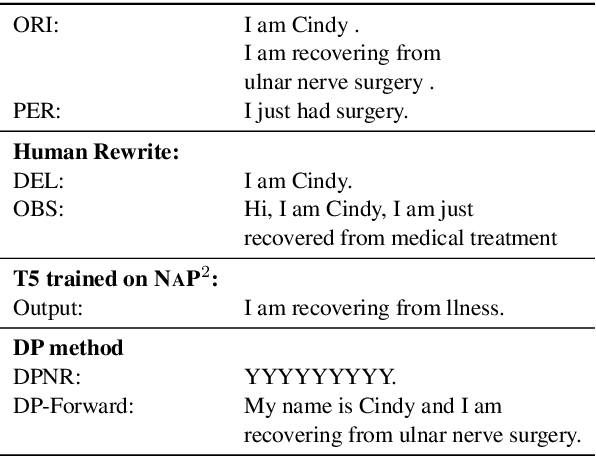
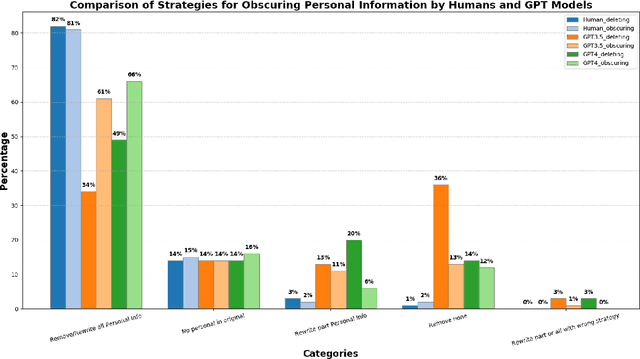
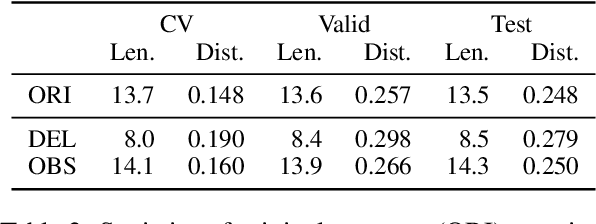
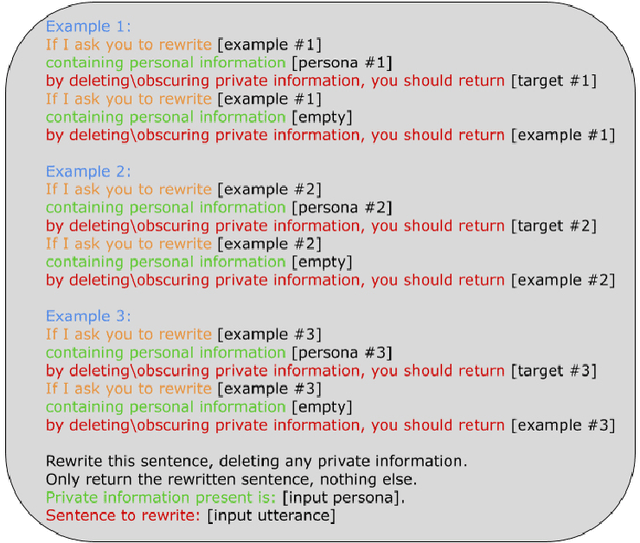
Abstract:Increasing concerns about privacy leakage issues in academia and industry arise when employing NLP models from third-party providers to process sensitive texts. To protect privacy before sending sensitive data to those models, we suggest sanitizing sensitive text using two common strategies used by humans: i) deleting sensitive expressions, and ii) obscuring sensitive details by abstracting them. To explore the issues and develop a tool for text rewriting, we curate the first corpus, coined NAP^2, through both crowdsourcing and the use of large language models (LLMs). Compared to the prior works based on differential privacy, which lead to a sharp drop in information utility and unnatural texts, the human-inspired approaches result in more natural rewrites and offer an improved balance between privacy protection and data utility, as demonstrated by our extensive experiments.
 Add to Chrome
Add to Chrome Add to Firefox
Add to Firefox Add to Edge
Add to Edge